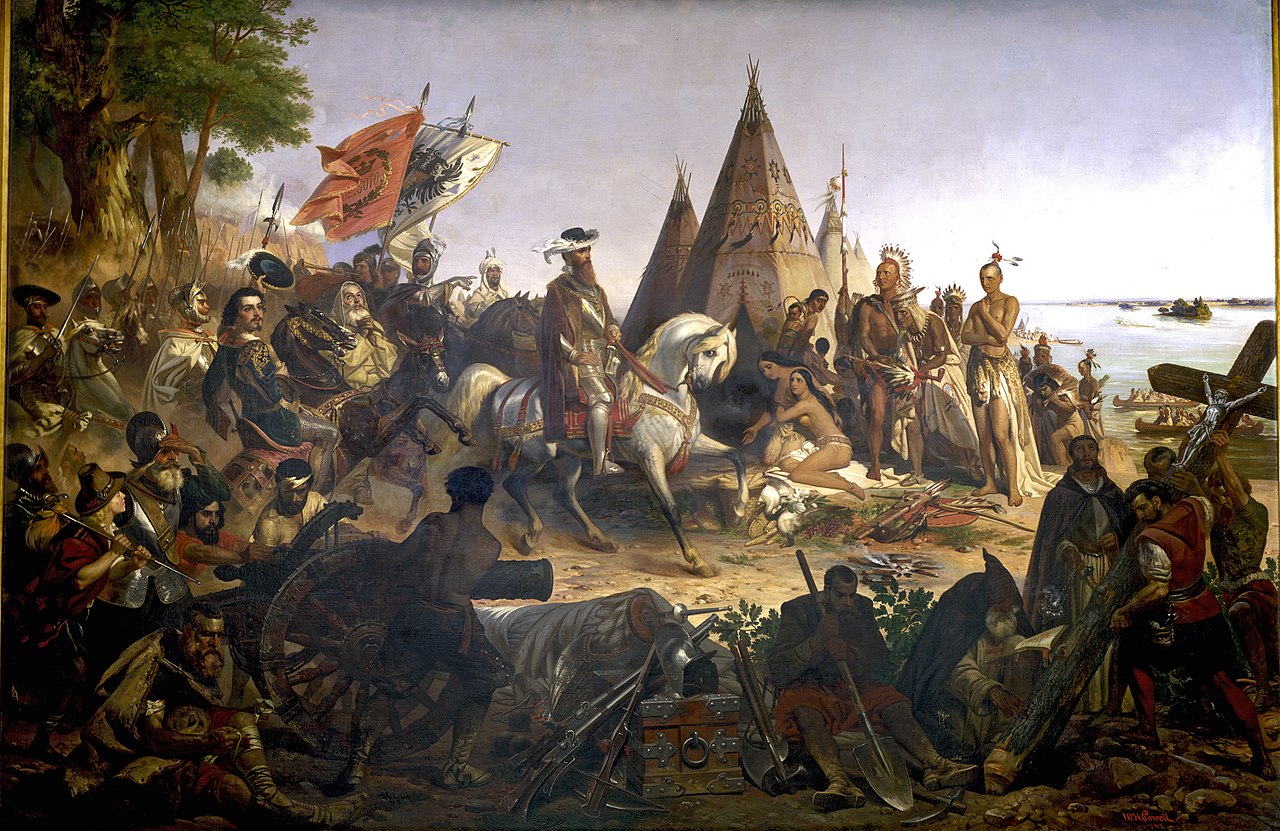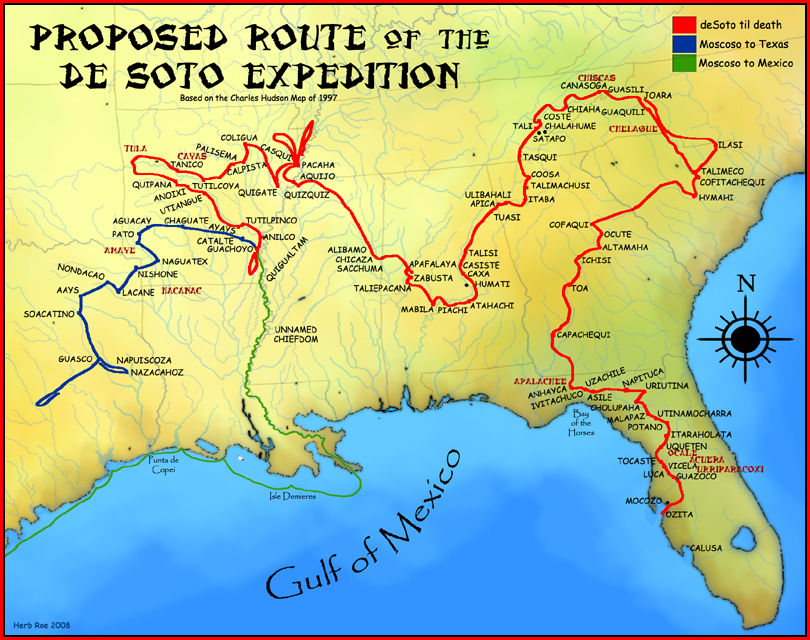7 De Soto on the Mississippi (1542)

Although we typically think of the Spanish Empire as conquering and colonizing Central and South America, the Spanish began their conquests more than a century before others such as the French, Dutch, Swedish, and English; and these conquests included attempts to explore North America and find sources of wealth there similar to those they had discovered in the Aztec and Inca Empires. One such attempt was that of Hernando De Soto (1500-1542), a Castilian who was instrumental in Pizarro’s conquest of Peru before receiving permission from King Charles V to undertake a four-year expedition in North America. De Soto brought 620 men and about 500 head of livestock including about 200 pigs. Many of these animals escaped and went feral in America.
De Soto landed in Florida and traveled across land that would later become Georgia, South and North Carolina, Tennessee, Alabama, Arkansas, Oklahoma, Texas, and Louisiana. In May 1542 De Soto died of a fever in a native village called Guachoya and the expedition returned to Mexico City under Luis de Moscosa. The name of this writer is not known — perhaps Alvaro Fernandez — but he was a member of this expedition. Italics are original; I have corrected the spelling of some archaic words.

Captain Soto was the son of a Squire of Xerez of Badaioz. He went into the Spanish Indies when Peter Arias of Avila was Governor of the West Indies. And there he was without anything else of his own, save his sword and target [shield]. And for his good qualities and valor, Peter Arias made him Captain of a troop of horsemen and by his commandment he went with Fernando Pizarro to the conquest of Peru where (as many persons of credit reported, which were there present) as well at the taking of Atadalipa [Atahualpa] lord of Peru, as at the assault of the city of Cusco and in all other places where they found resistance, wheresoever he was present, he passed all other Captains and principal persons. For which cause, besides his part of the treasure of Atadalipa, he had a good share whereby in time he gathered an hundred and four-score thousand Duckets together, with that which fell to his part. Which he brought into Spain, whereof the Emperor borrowed a certain part, which he repaid again with 60,000 Rials of plate in the rent of the silks of Granada. And all the rest was delivered him in the contractation house of Seville. He took servants, to wit a Steward, a Gentleman Usher, Pages, a Gentleman of the Horse, a Chamberlain, Lackeys and all other officers that the house of a Noble man requires. The Emperor made him the Governor of the Isle of Cuba and Adelantado or President of Florida with a title of Marques of a certain part of the lands that he should conquer.
On Sunday the 18th of May, in the year of our Lord, 1539, the Adelantado or president departed from Havana in Cuba with his fleet, which were nine vessels, five great ships, two caravels, and two brigantines. They sailed seven days with a prosperous wind. On Friday the 30th of May they landed in Florida, two leagues from a town of an Indian Lord, called Veita. He left Captain Calderan at the Port with thirty horsemen and seventy footmen, with provision for two years, and himself with all the rest marched into the mainland and came to the Paracossi, at whose town Baltasar de Gallegos was. And from thence with all his men took the way to Cale.
This River . . . was that which . . . fell into Rio grande, or the Great River [Mississippi], which passed by Pachaha and Aquixo near unto the province of Guachoya. And the Lord thereof came up the River in canoes to make war with him of Nilco. On his behalf there came an Indian to the Governor and said unto him that he was his servant, and prayed him so to hold him, and that within two days he would come to kiss his Lordships hands. And at the time appointed he came with some of his principal Indians which accompanied him and with words of great offers and courtesy he gave the Governor a present of many Mantles and Deers skins. The Governor gave him some other things in recompense and honored him much. He asked him what towns there were down the River? He answered that he knew none other but his own and on the other side of the River a province of a Cacique called Quigalta. So he took his leave of the Governor and went to his own town. Within few days the Governor determined to go to Guachoya, to learn there whether the Sea were near or whether there were any habitation near where he might relieve his company, while the brigantines were making, which he meant to send to the land of the Christians. As he passed the River of Nilco there came in canoes Indians of Guachoya up the stream and when they saw him, supposing that he came to seek them to do them some hurt, they returned down the River and informed the Cacique thereof. Who with all his people, spoiling the town of all that they could carry away, passed that night over to the other side of Rio grande or the Great River. The Governor sent a Captain with fifty men in six canoes down the River and went himself by land with the rest. He came to Guachoya upon Sunday the 17th of April. He lodged in the town of the Cacique, which was inclosed about and seated a crossbow shot distant from the River.
The Governor fell into great dumps to see how hard it was to get to the Sea. And worse, because his men and horses every day diminished, being without succor to sustain themselves in the country. And with that thought he fell sick, being evil handled with fevers and was much aggrieved that he was not in case to pass presently the River and to seek him to see if he could abate that pride of his, considering the River went now very strongly in those parts. For it was near half a league broad and 16 fathoms deep and very furious, and ran with a great current. And on both sides there were many Indians and his power was not now so great, but that he had need to help himself rather by flights than by force.
. . . the 21st of May, 1542, departed out of this life the valorous, virtuous, and valiant Captain, Don Fernando de Soto, Governor of Cuba and Adelantado of Florida. Whom fortune advanced, as it used to do others, that he might have the higher fall. He departed in such a place and at such a time, as in his sickness he had but little comfort. And the danger wherein all his people were of perishing in that Country, which appeared before their eyes was cause sufficient why every one of them had need of comfort and why they did not visit nor accompany him as they ought to have done. Luis de Moscoso determined to conceal his death from the Indians, because Fernando de Soto had made them believe that the Christians were immortal.
As soon as he was dead, Luis de Moscoso commanded to put him secretly in an house, where he remained three days. And removing him from thence, commanded him to be buried in the night at one of the gates of the town within the wall. And as the Indians had seen him sick and missed him, so did they suspect what might be. And passing by the place where he was buried, seeing the earth moved, they looked and spake one to another. Luis de Moscoso understanding of it, commanded him to be taken up by night and to cast a great deal of sand into the mantles wherein he was winded up, wherein he was carried in a canoe and thrown into the midst of the River.
Source: “From the Ocean to the Mississippi” (1539-1542), translated by Richard Hakluyt, 1609, American History Told by Contemporaries, Albert Bushnell Hart, 1897, 57-9. https://archive.org/details/in.ernet.dli.2015.45493/page/n77/mode/2up
